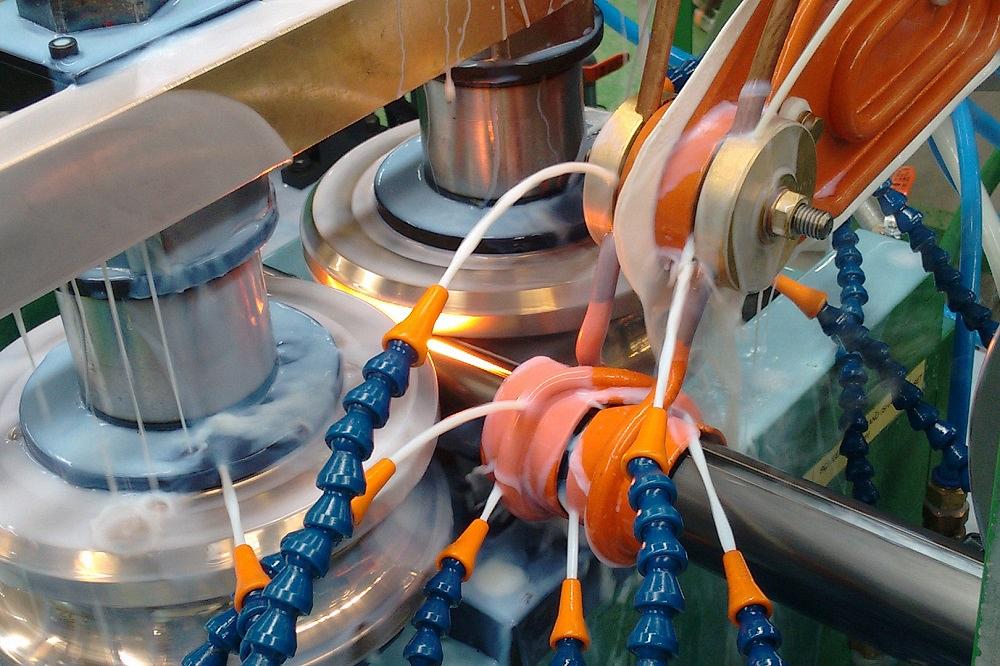- FMA
- The Fabricator
- FABTECH
- Canadian Metalworking
Categories
- Additive Manufacturing
- Aluminum Welding
- Arc Welding
- Assembly and Joining
- Automation and Robotics
- Bending and Forming
- Consumables
- Cutting and Weld Prep
- Electric Vehicles
- En Español
- Finishing
- Hydroforming
- Laser Cutting
- Laser Welding
- Machining
- Manufacturing Software
- Materials Handling
- Metals/Materials
- Oxyfuel Cutting
- Plasma Cutting
- Power Tools
- Punching and Other Holemaking
- Roll Forming
- Safety
- Sawing
- Shearing
- Shop Management
- Testing and Measuring
- Tube and Pipe Fabrication
- Tube and Pipe Production
- Waterjet Cutting
Industry Directory
Webcasts
Podcasts
FAB 40
Advertise
Subscribe
Account Login
Search
Cooling equipment manufacturer saves time, energy costs with HF tube welder
- March 30, 2021
- News Release
- Tube and Pipe Production
Situation
A large North American manufacturer of cooling and heat transfer equipment was using an electric resistance welding (ERW) copper wheel system to produce tubular products for its equipment. And for almost eight years, the company discussed upgrading its machines to be rid of the challenges they presented.
“When we were running the ERW copper wheel system before, we had to make sure the seam was straight up, the profile was just right, and start the welder by producing scrap to allow the copper wheel to heat up before everything was ready to go,” said the plant engineer.
Resolution
The equipment manufacturer chose a Thermatool high-frequency (HF) welding machine with HAZControl technology and a variety of welding frequencies. It features a user-friendly operator console that stores recipes for future use.
“All we have to check before starting the high-frequency welder is that the recipe profile that we’ve saved in our system matches the pipe we plan to fabricate,” the plant engineer explained. “Once started, the system takes over right where it left off and adjusts automatically from there.”
Thermatool machines also offer stabilized output power from 50 to 2,000 kW. Since operators can maintain a stable welding frequency and stable power output, even at low power levels, every tube from startup to full speed to shutdown has the same weld quality, and scrap is minimized.
As a result, energy usage at the cooling equipment manufacturer has improved.
“We knew going to an HF welder would consume less power than the copper wheel, so we installed a power data logger on both machines to see exactly how much power we saved,” said the plant engineer. “With our Thermatool machine, we’re utilizing 54% less energy compared to the weld wheel system we used to have. In addition, we’re not consuming any power at all on standby mode. Plus, we’ve seen our run time percentage reduced by 50.1%, while our mill speed increased by exactly 25%. It’s miles ahead of what we’ve had in the past.
“When we finally upgraded, it was one of the best decisions this company has made. The power and scrap savings alone are worth it, never mind the quality and the control,” said the plant engineer. “It’s a huge step in the right direction.”
Related Companies
subscribe now

The Fabricator is North America's leading magazine for the metal forming and fabricating industry. The magazine delivers the news, technical articles, and case histories that enable fabricators to do their jobs more efficiently. The Fabricator has served the industry since 1970.
start your free subscription- Stay connected from anywhere

Easily access valuable industry resources now with full access to the digital edition of The Fabricator.

Easily access valuable industry resources now with full access to the digital edition of The Welder.

Easily access valuable industry resources now with full access to the digital edition of The Tube and Pipe Journal.
- Podcasting
- Podcast:
- The Fabricator Podcast
- Published:
- 04/16/2024
- Running Time:
- 63:29
In this episode of The Fabricator Podcast, Caleb Chamberlain, co-founder and CEO of OSH Cut, discusses his company’s...
- Industry Events
16th Annual Safety Conference
- April 30 - May 1, 2024
- Elgin,
Pipe and Tube Conference
- May 21 - 22, 2024
- Omaha, NE
World-Class Roll Forming Workshop
- June 5 - 6, 2024
- Louisville, KY
Advanced Laser Application Workshop
- June 25 - 27, 2024
- Novi, MI































